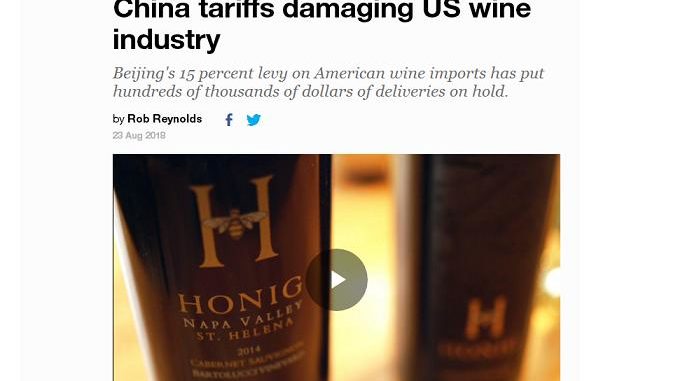
By Jim Boyce | Quite a story by Al Jazeera about China’s tariff on U.S. wines, one featuring Napa Valley’s Honig. And, in my opinion, missing a lot of context. Let’s quickly break it down.
Al Jazeera’s Rob Reynolds: “Winery owner Michael Honig is afraid that relationships he’s spent a decade cultivating with Chinese wine merchants have now been ruined.”
Why? Because those relationships will be politically difficult for the Chinese partners? Because higher prices for U.S. wines means those partners will look elsewhere for products? Because, if they are the type to give up a few months into a tariff, they weren’t very good partners in the first place? For some other reason?
Michael Honig: “We sell to about 25 countries outside of the US and China is certainly one of the top two or three.”
That symbolizes the position of U.S. wines vis-a-vis China, one of many nations in which they are sold. China has long been more about tomorrow, about potential, than about impressive results today. As I noted in my post “ten quick takes“:
The U.S. only exports about 12.5% of production and, in 2017, only 3.7% of those exports went to China. That means about 0.4% of total production or 1 out of every 250 bottles.
For added perspective, six times more wine goes to Canada than China, both by value and volume, and even more goes to the European Union.
I don’t mean to minimize the situation of Honig. I have no idea what else he said to Reynolds and I don’t dispute that some individual producers feel economic pain, but it is important to note China does not consume a large amount of U.S. wine.
Reynolds: “Now U.S. wines are priced out of the Chinese market compared to the fruits of Chilean, French and Australia vineyards.”
No they’re not. They’re simply pricier, at least those for which producers and importers are passing on instead of swallowing the tariff. Wines become pricier or cheaper all the time due to trade deals, currency fluctuations, market demand and other factors.
Some consumers will balk at a price rise but is only one factor. Honig himself states (see below) that consumers “want the finest things in life”. Those people realize U.S. wines aren’t cheap, aren’t “bargain bin” options, and they aren’t necessarily going to stop buying their favorite USD100Â U.S. wine because it now costs USD115.
Honig: “[Chinese consumers]Â want wine, they want the finest things in life, they know that Napa Valley produces some of the best wines in the world, so we have this great opportunity but the government is putting this huge impediment in front of us.”
Speaking of huge impediments. Between 2011 and 2017, long before the tariff, the market for bottled wine imports to China doubled, with Australia and France leading the way. During that same period, U.S. wine exports to China fell from 16.1 million liters in 2011 to 14.2 million liters in 2017 (U.S.-based Wine Institute numbers). A tariff is hardly the only or biggest issue facing U.S. wines in China. (More on this soon.)
Frankly, a more likely threat to U.S. wines than a rise in price is a rise in nationalism, one that would see Chinese consumers boycott or be cautious about publicly buying them. Also crucial is the current feeling of economic uncertainty among many consumers, ones that could see them buying not only less U.S. wine but also less wine in general, and that would be something of concern to all who sell in China.
Sign up for the Grape Wall newsletter here. Follow Grape Wall on LinkedIn, Instagram, Facebook and Twitter. And see my sibling sites World Marselan Day, World Baijiu Day and Beijing Boyce. Grape Wall has no advertisers, so if you find the content useful, please help cover the costs via PayPal, WeChat or Alipay. Contact Grape Wall via grapewallofchina (at) gmail.com.
Leave a Reply
You must be logged in to post a comment.